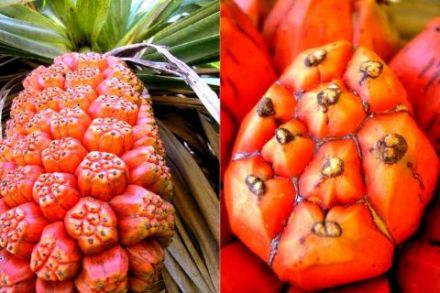 |
The fruits are globose, 10 to 20 cm in diameter, and have many prism-like sections, resembling the fruit of the pineapple. Typically, the fruit changes from green to bright orange or red as it matures. The fruit of some species are edible.
Cooking
Pandan leaves are used in Southeast Asian cooking to add a distinct aroma to rice and curry dishes such as nasi lemak, kaya ('jam') preserves, and desserts such as pandan cake. Pandan leaf can be used as a complement to chocolate in many dishes, such as ice cream. Fresh leaves are typically torn into strips, tied in a knot to facilitate removal, placed in the cooking liquid, then removed at the end of cooking. They are also used to wrap food for cooking, such as gai haw bai dteuy ("chicken wrapped in pandanus leaves"), and are neatly folded into small baskets for filling with puddings and cakes.
Pandan has an earthy fragrance and taste that enrich coconut milk and syrupy mixtures in the making of sweet foods. A Thai equivalent to vanilla, bai dteuy is one of the most popular flavorings for coconut desserts, second only to the sweet essence of mali blossoms (jasmine). Country folk use the leaves to boil with water for drinking purposes, adding a refreshing, almost smoky taste, reminiscent of the juice of roasted coconuts.

You need only two to three whole leaves to flavor a couple of cups of coconut milk. Simmer ten to fifteen minutes, or until the milk is richly flavored. Squeeze all the juice out from the leaves before discarding; these last drops are the most fragrant.

-

 Recipes
Recipes
-

 Products
Products
-

 Entertaining
Entertaining
-

 Chefs
Chefs
-

 Hints & Tips
Hints & Tips
-

 Glossaries
Glossaries








